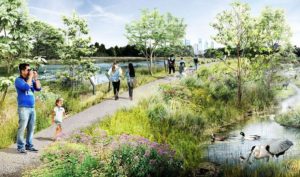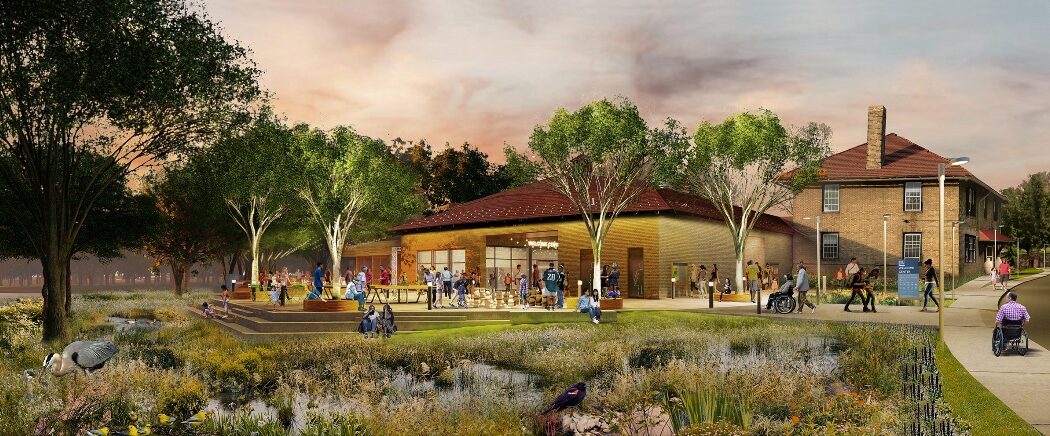On August 18, 2022, another chapter began in the long-running effort (chronicled here in REVITALIZATION) to restore Philadelphia‘s Franklin Delano Roosevelt Park (FDR Park): the city’s iconic 348-acre park, which was carved out of the tidal marshes in South Philadelphia.
That was when Philadelphia Parks and Recreation (PPR), Fairmount Park Conservancy (FPC), and the Friends of FDR Park joined the Philadelphia International Airport (PHL) to announce the start of construction on a restoration project that will create a 33-acre native coastal forested wetland in the Southwest corner of FDR Park.
The $30 million effort will reclaim high quality habitat in the park and reintroduce native ecosystems to the land for the first time since the park was completed in 1914.
 “Returning part of FDR Park to wetland is an important step toward creating and maintaining a world class public park that is built on the Delaware River watershed,” said Maura McCarthy, Ph.D., Executive Director, Fairmount Park Conservancy.
“Returning part of FDR Park to wetland is an important step toward creating and maintaining a world class public park that is built on the Delaware River watershed,” said Maura McCarthy, Ph.D., Executive Director, Fairmount Park Conservancy.
“The wetland and creek project will make FDR Park a paradise for birds and local birdwatchers, and open up a section of the park that has been inaccessible for decades,” she continued.
A coastal forested wetland is native to the FDR Park site, and was once the primary landscape in much of the Delaware River watershed in South and Southwest Philadelphia.
The PHL project will create this habitat in a currently inaccessible area of FDR Park. The project will rebuild and enhance the riverbank areas adjacent to Shedbrook Creek, reducing flooding, and provide new opportunities to explore both creek and marshland in the park.
The wetland will expand habitat for native flora and fauna and include boardwalks for public access.
Wetlands are areas where land is regularly covered by water and make ideal habitat for fish, amphibians, and water birds.
To create a wetland, the land will first be cleared of current growth – a process called grubbing. The grubbing will remove decades of overgrowth by invasive species, followed by planting 7000 new trees adapted to wetland habitat as well as 1700 bushes and woody shrubs.
 “FDR Park is a home to so many rich Philadelphia communities, from birders and hikers, to youth athletes, cultural institutions, and naturalists,” said Philadelphia Parks & Recreation Commissioner Kathryn Ott Lovell.
“FDR Park is a home to so many rich Philadelphia communities, from birders and hikers, to youth athletes, cultural institutions, and naturalists,” said Philadelphia Parks & Recreation Commissioner Kathryn Ott Lovell.
“The wetland project and Nature Phase of the Park Plan will deliver for those who love FDR Park today, while building a sustainable, resilient foundation that will allow future generations of South Philadelphia families to enjoy FDR Park for years to come,” she added.
The 12-18 month construction project will also include the installation of two new tide gates at the park to prevent tidal flow to the park’s creeks and lagoons. The new gates will replace an aging, malfunctioning tidal gate and improve access for maintenance.
Finally, creating a low-lying habitat like a wetland requires significant excavation to remove decades of accumulated soil.
Suitable excavated materials will be preserved on 10.60 acres of the former golf course for future use in elevating the park above sea level. The soil will be planted with natural grasses and wildflowers.
“A lot of work has already gone on behind the scenes to get this project to the groundbreaking stage,” said Philadelphia International Airport Division of Aviation Interim CEO Keith Brune.
“We are excited for the work at FDR Park to be underway. When completed, this project will improve the park for the entire community, by removing years of debris, planting thousands of trees and shrubs, improving drainage and clearing clogged pipes,” he explained.
The Nature Phase
The wetland creation marks the beginning of implementation of the Nature Phase of the FDR Park Plan. The wetland project is the first of 12 projects for this Nature Phase, representing over $45 million in investment into the park’s sustainability and restoration.
The Nature Phase, encompassing 100 acres of the Park Plan’s Ecological Core, will include:
- 33 acres of the FDR Park’s southwest border transformed into tidal wetland;
- Restoration of Shedbrook Creek stream and riparian buffers;
- 23 acres of Sedge Meadow with boardwalks and overlooks;
- Kayak and canoe launch;
- Wildflower Hill;
- Nature Playground;
- Treehouse Woods
- High-quality forest in FDR
- Canopy structure for explorations;
- 5 miles of soft surface trail network with signage;
- Plant nursery and land care facility;
- Trailhead comfort station; and
- Meadow and forest restoration.
The Nature Phase reflects updates to the FDR Park plan that will expand the total high quality habitat, resulting in 60 percent of the park’s 348 acres dedicated to natural areas such as woodlands, meadows, trails, wetlands, and water. The Nature Phase implementation begins in 2022 and will likely continue until 2026.
Funders for the Nature Phase include the City of Philadelphia, The Philadelphia International Airport, the Commonwealth of Pennsylvania Redevelopment Assistance Capital Program, PA-DEP Coastal Zone Management, and National Fish & Wildlife Foundation.
Designed by the Olmsted Brothers in 1914, FDR Park’s sequence of picturesque lakes with adjacent lawns are connected by a network of carriage and foot paths. In 1926, the park hosted the national Sesquicentennial Exhibition and several grand civic buildings, including the iconic Boathouse, opened for the first time.
Today, FDR Park hosts a playground, 4 baseball diamonds, a renowned skate park, a network of lakes, the Swedish American Museum, and 126 acres of woodland. In 2019, after engaging with nearly 3,000 community members and stakeholders, Philadelphia Parks & Recreation and the Fairmount Park Conservancy published a park plan to reimagine a historic Olmsted Park to serve 21st-century Philadelphians. The plan, designed by WRT, creates an ecologically sustainable vision for FDR Park that inspires investment, meets the needs of all users today and tomorrow, and focuses on resiliency in the face of a changing climate.
All images courtesy of Philadelphia Parks and Recreation.

